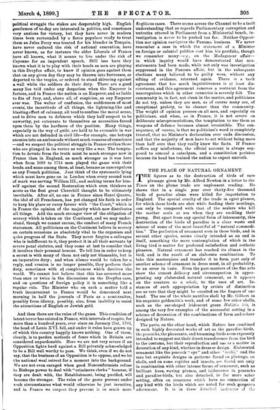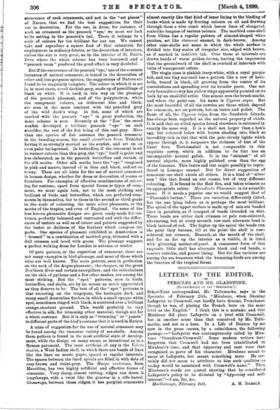THE PLACE OF NATURAL ORNAMENT.
THE figures as to the destruction of birds of rare plumage given by Mr. Alfred Newton in a letter to the Times on the plume trade are unpleasant reading. He shows that in a single year over thirty-five thousand birds of paradise alone were killed for importation to England. The special cruelty of the trade in egret plumes, for which these birds are shot while feeding their nestlings, can only be compared with that of the sealers who kill the mother seals at sea when they are suckling their young. But apart from any special form of inhumanity, this destruction of the birds of paradise is a clear waste and misuse of some of the most beautiful of "natural commodi- ties."' The perfection of ornament seen in these birds, and in several other species, seems clearly intended as an end in itself, something the mere contemplation of which in the living bird is matter for profound satisfaction and reathetic pleasure. Natural ornament has reached its climax in the bird, and is the result of an elaborate combination. To take this masterpiece and transfer it to form part only of another scheme of ornament in dress must, in all probability, be an error in taste. Even the past-masters of the fine arts show the utmost delicacy and circumspection in appro- priating any elaborated natural ornament, as it appears on the creature as a whole, to the uses of art. In- stances of such appropriation by artists of distinction are so rare that they might be counted on the fingers of one hand. The use of the whole nautilus shell by Mr. Gilbert in his exquisite goldsmith's work, and of some few other shells, such as the ear-shaped iridescent green Haliolis iris, is, among the very few examples of the successful setting in a scheme of decoration of the combinations of form and colour designed by Nature.
The parts, on the other hand, which Nature has combined in such highly decorated works of art as the paradise-birds, the peacocks, the pheasants, and humming-birds seem expressly intended to suggest not their direct transference from the bird to the costume, but their reproduction and use as a motive in decoration of any kind, whether in dress or design. Elaborated ornament like the peacock "eye" and other " ocelii," and the rare but exquisite designs in patterns found on plumage, on shells, and on some reptiles and insects, are found not only in combination with other intense forms of ornament, each as brilliant hues, waving plumes, and iridescence in peacocks and paradise-birds, but also detached, in far more sober setting, often on creatures which have no connection of any kind with the birds which are noted for such gorgeous adornment. It is :n these detacbea ins:anus of :La occurrence of such ornaments, and not in the "set pieces" of Nature, that we find the best suggestions for their use in decoration. For the use, in dress, for instance, of such an ornament as the peacock "eye," we must not look to its setting in the peacock's tail. There it belongs to a scale of colours far too brilliant for our use. We cannot take and reproduce a square foot of that coloration for employment in ordinary fabrics, or the decoration of interiors, unless the size is very great, as in the interior of St. Paul's. Even where the whole scheme has been borrowed and a "peacock room" produced the good effect is very doubtful.
But if the occurrence of the peacock "eye," one of the common instances of natural ornament, is traced in the decoration of other and less gorgeous species, the suggestions of Nature are found to be singularly complete. The colour in which it is set is, in most cases, a cool darkish grey, made up of pencillings of black on white. It is used in this way on the plumage of the peacock pheasant, and of the polyplectron, while the component colours, an iridescent blue and black, are seen in the same contrast with the pencilled grey of the wild duck's wing. In fish, some of which are marked with the peacock " eye " in great perfection, the same scheme is seen. Recently at the " Zoo " the eared sunfish developed a brilliant peacock " eye " on each shoulder, the rest of the fish being of this cool grey. More than one species of fish assumes the peacock ornament in the breeding season, the small girardinns from Trinidad having it as strongly marked as the sunfish, and set on an even paler background. In butterflies, if the ornament is set in warmer colours than this grey, the " eye " itself is paler and less elaborated, as in the peacock butterflies and certain of the silk moths. Other silk moths have the " eye " composed in pink and mauve, instead of in blue and black, and set on tawny. These are all hints for the use of natural ornament in human design, whether for dress or decoration of rooms or furniture. For examples of effective combinations of colour- ing for costume, apart from special forms or types of orna- ment, we must again look, not to the most striking and brilliant of birds and butterflies, which are perfected orna- ments in themselves, but to those in the second or third grade in the scale of colouring, the more sober pheasants, or the moths of the tropics, and even of England. On some of the less known pheasants designs are given ready-made for cos- tumes, perfectly balanced and contrasted and with the differ- ences of texture as well as of colour and pattern suggested by the lustre or dullness of the feathers which compose the parts. One species of pheasant exhibited at Amsterdam is " dressed " in a combination of mottled grey, trimmed with a dull crimson and laced with green. The plumage suggests a perfect walking dress for London in autumn or winter.
Of pure pattern, or the repetition of ornament, there are not many examples in bird-plumage, and most of those which exist are well known. The scale pattern, seen in perfection on the neck of the Argus pheasant ; the chequer, on the great Northern diver and certain caterpillars; and the reticulations on the skin of pythons and a few other snakes, are among the most striking. But the " spot " patterns, seen in birds, butterflies, and shells, are by no means as much appreciated as they deserve to be. The best of all the " spot " patterns is that recurring on the tragopans, the harlequin duck, and many small Australian finches, in which a small opaque-white spot, sometimes ringed with black, is scattered over a brilliant orange-chestnut ground. This would probably be very effective in silk, for trimming other material, though not for a whole costume. But it is only as " trimming " or " panels " to different parts of the bird's costume that it is used in Nature.
A mine of suggestion for the use of natural ornament may be found among the immense variety of sea-shells. Among them pattern is found in its most artificial state of develop- ment, while the design on many seems as intentional as in a Roman pavement. The most artificial of any is the Voluta musica, a West Indian shell, in which there are bands of lines like the lines on music paper, spaced at regular intervals. The spaces between the lined spirals are filled in with dots of rosy-brown and violet-grey. The Harpa rentricosa, from Mauritius, has two highly artificial and effective forms of ornament. Very sharp, almost cutting, ridges run down it lengthways, with a twist like the grooves in a rifle-barrel. Crossways, between these ridges, it has purplish ornaments almost exactly like that kind of inner lining to the binding of books which is made by floating colours on oil and drawing through them a wire comb which leaves lines of elongated, scale-like tongues of various colours. The marbled cone-shell from China has a regular pattern of almond-shaped white patches, set like claisomth enamel, in dark-brown. Among other cone-shells are some in which the whole surface is divided into tiny scales of irregular size, edged with brown, as if marked in indelible ink. Over these at intervals are drawn bands of warm golden-brown, leaving the impression that the groundwork of the shell is overlaid at intervals with belts of transparent colour.
The virgin cone is pinkish ivory-white, with a royal purple tail, and one tiny sea-snail has a pattern like a row of hare- bells, traced in black, all growing from the centre of its convolutions and spreading over its broader parts. One not very beautiful cowry has yellow rings apparently painted on its back by an unskilful artist. One almost sees the brush-marks, and where the paint ran. Its name is Cyprma argus. But the most beautiful of all the cowries are those which depend for ornament, not on pattern, but on lustre and polish. The finest of all, the Cypnea talpa, from the Sandwich Islands, has always been regarded as the natural property of chiefs. It is said that an allied species found elsewhere is esteemed in exactly the same way. It is a shell not larger than a hen's egg, but coloured below with brown shading into black so incredibly rich in tint that with the pale cloudy lights which appear through it, it surpasses the richness of tint of the finest furs. Tortoiseshell is not comparable to this exquisite cowry, whieh in addition to its tint has an incomparable natural polish. It is the "shiniest" of all natural objects, more highly polished even than the egg of the tinamou. This lustre and tint might possibly be repro- duced in Limoges enamel. But for direct suggestion of ornament one shell excels all others. It is a kind of "silver nun" like that found on our coasts, but of very different colouring. It is found in the Red Sea, and takes crimson as its appropriate colour. Monodonta Pharaonis is its scientific name. If it needs a popular one we would suggest that of "Pharaoh's button." There are varieties, differently tinted, but the one lying before us is perhaps the most brilliant. The spiral of the upper surface is made up of min ute beaded lines in parallels, as if compact of beads threaded on wire. These beads are either dark crimson or pale rose-coloured, alternating, but at every seventh row each alternate bead is black instead of red. The higher up the spiral the beads run the paler they become, till at the point the shell is rose- coloured, not crimson. Beneath, at the mouth of the shell, and for so far up the interior as is visible, it is lined with glittering mother-of-pearl. A commoner form of this exquisite little shell has alternate black and red bands, a coarser exterior, and poorer lining. But the fine varieties are among the sea treasures what the humming-birds are among the beauties of the tropical forest.







































 Previous page
Previous page